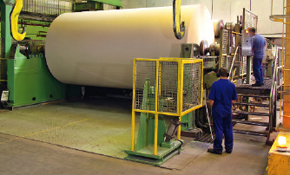24 6 月, 2022
Analysis: UK paper packaging moves back into the fold
When the recent recession hit the UK, the paper-based packaging sector was already in a deep down-turn. Now, with significant investment in new capacity, things are looking up, says Simeon Goldstein

January was a month of highs and lows for paper-based packaging in the UK. The news that SAICA had given the final go-ahead for its £290m recycled paper mill near Manchester came days after Western Corrugated closed its doors after going into administration. The two events highlight very well the current situation of the sector as a whole; namely that while things are undoubtedly tough at the moment there is some light at the end of the tunnel.
If the recession was the story of 2009 it did not come as a surprise to many and in the case of paper-based packaging deepened what was already a downward pattern. UK mills produced around 4.3m tonnes of paper and board last year. While this 14% drop on 2008 represents a significant contribution to the total 31% reduction in the five years since 2004, Confederation of Paper Industries (CPI) corrugated sector manager Andrew Barnetson is keen to point out that because the recession was not the start of the sector’s problems it was, to some extent, better prepared for it.
“The paper and board packaging industry had been facing difficulties for some time before the recession hit and developed new strategies accordingly, such as point-of-sale displays and niche, high-value products such as cinema foyer stands,” he says.
Nonetheless, UK capacity has been in decline for several years now and Barnetson says UK mills have closed because of rising energy costs, the regulatory burden and increasingly global markets that make it easier to import material. PricewaterhouseCoopers global forest, paper and packaging industry leader Clive Suckling also suggests the major reductions in board production in the UK are, in part, a reflection of bigger trends such as firms moving to lower-cost locations. “The big story for the past few years has been no plans for new capacity and existing capacity struggling to get to grips with lighter-weight materials,” he says.
New capacity
This situation is now beginning to change, with the SAICA investment and DS Smith’s Kemsley mill in Kent leading the way by bringing some much-needed new UK capacity and using state-of-the-art machinery to produce the lighter-weight materials that the market is demanding. New capacity also has a knock-on effect on the environment as it means more recovered material can be recycled in the UK.
“The vast majority – some 90% – of the raw material we use is recovered fibre and, as we’ve lost capacity, we’ve lost the ability to recycle domestically,” says the CPI’s Barnetson. As paper collections have increased, recovered paper exports have risen by 72% in the past five years because of the lack of capacity to deal with it here.
But, despite the positive mood in terms of production, use of paper is still falling, albeit broadly in line with what is produced. UK paper and board consumption has dropped by 19% in the past five years – by 10% in 2009 alone. Although the sector is generally confident about the stability of consumer packaging for food and drink and some recovery for industrial and general transit packaging, it is calling for more government support for manufacturing as a whole. “Everybody has an issue with a declining manufacturing sector; government support would mean more demand for UK packaging. Further support for recycling would mean a double whammy of increased requirements for paper and the capability to actually use it,” says Barnetson.
World-class facilities
The CPI is keen to paint a positive picture and, as Barnetson says, the situation is far from bleak as mills return to the UK. “Yes, the numbers are down, but that is the society we are playing in,” he says. Increased UK capacity could also benefit from the current weakness of the pound, particularly compared to the euro.
PwC’s Suckling says that capacity has been lost across the continent and what is left can vary in terms of age of machines and product. Investment in world-class production facilities, such as SAICA’s site in Manchester, could provide enough capacity for UK firms to export as well.
“I think that the situation is, in some ways, more positive for the UK than for the rest of Europe. There is definitely room for the new capacity and it could prove to be an attractive export location for the eurozone,” he says. “There’s also the fact that major structural change has already happened and those firms who might look to leave the UK to take advantage of lower-cost economies will have done so already.”
The future for the UK’s paper packaging industry seems solid, particularly if a new government gives manufacturing a much-needed boost. If that happens, it should help bring the light at the end of the tunnel that bit closer.
UK 2009 PAPER AND BOARD STATISTICS
In tonnes (% change on 2008)
Consumption (-10%)
2009 11.5m
2008 12.78m
Production (-14%)
2009 4.3m
2008 5m
Collected for recycling (-7%)*
2009 8.1m
2008 8.7m
UK reprocessing (-6%)
2009 3.8m
2008 4.04m
Export reprocessing (-8%)
2009 4.5m
20084.9m
*While the quantity collected fell, it rose as a percentage of the amount consumed to 78%

